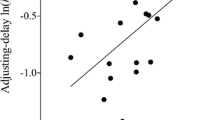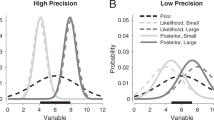Abstract
Rationale
Delay-discounting procedures involving choice between small immediate rewards and large delayed rewards are used to study impulsivity in rodents. Improving existing procedures may provide new insights into the neurobiological mechanisms underlying decision-making processes.
Objectives
To develop a novel delay-discounting procedure that adjusts the delay value within individual sessions based on the rat’s most recent choices.
Methods
Compared to previously developed procedure, we required a more consistent demonstration of preference, five consecutive choices of the large or small reward, a criterion that is more likely to reflect deliberate choice by the animal, as opposed to two consecutive choices. In addition, delays were changed in steps of 5 s (rather than 1 s), because 5-s increments should be more easily discriminated and may produce a more distinct effect on choice. We characterized the procedure behaviorally by manipulating the duration of the session and the consecutive choice criterion, and we investigated the stability of the behavior upon interruption of training. We also characterized the procedure pharmacologically by investigating the effects of dopaminergic compounds.
Results
Our procedures allowed obtaining two complementary measures of delay discounting: (1) the percentage of choices of the delay option and (2) the mean adjusting delay, an index of the delay that animals choose more frequently. We found that our procedure rapidly establishes a baseline of choice behavior that remains stable over time and is highly sensitive to manipulations of the dopaminergic system.
Conclusions
This procedure may provide a useful tool for investigating the neurobiology of inter-temporal choice and decision-making.






Similar content being viewed by others
References
Addessi E, Paglieri F, Focaroli V (2011) The ecological rationality of delay tolerance: insights from capuchin monkeys. Cognition 119:142–147
Ainslie GW (1974) Impulse control in pigeons. J Exp Anal Behav 21:485–489
Broos N, Schmaal L, Wiskerke J, Kostelijk L, Lam T, Stoop N, Weierink L, Ham J, de Geus EJ, Schoffelmeer AN, van den Brink W, Veltman DJ, de Vries TJ, Pattij T, Goudriaan AE (2012) The relationship between impulsive choice and impulsive action: a cross-species translational study. PLoS One 7:e36781
Cardinal RN, Robbins TW, Everitt BJ (2000) The effects of d-amphetamine, chlordiazepoxide, alpha-flupenthixol and behavioural manipulations on choice of signalled and unsignalled delayed reinforcement in rats. Psychopharmacology 152:362–375
Cardinal RN, Daw N, Robbins TW, Everitt BJ (2002) Local analysis of behaviour in the adjusting-delay task for assessing choice of delayed reinforcement. Neural Netw 15:617–634
Craig AR, Maxfield AD, Stein JS, Renda CR, Madden GJ (2014) Do the adjusting-delay and increasing-delay tasks measure the same construct: delay discounting? Behav Pharmacol 25:306–315
Diergaarde L, Pattij T, Poortvliet I, Hogenboom F, de Vries W, Schoffelmeer AN, De Vries TJ (2008) Impulsive choice and impulsive action predict vulnerability to distinct stages of nicotine seeking in rats. Biol Psychiatry 63:301–308
Evenden JL, Ryan CN (1996) The pharmacology of impulsive behaviour in rats: the effects of drugs on response choice with varying delays of reinforcement. Psychopharmacology 128:161–170
Evenden JL, Ryan CN (1999) The pharmacology of impulsive behaviour in rats VI: the effects of ethanol and selective serotonergic drugs on response choice with varying delays of reinforcement. Psychopharmacology 146:413–421
Floresco SB, Tse MT, Ghods-Sharifi S (2008) Dopaminergic and glutamatergic regulation of effort- and delay-based decision making. Neuropsychopharmacology 33:1966–1979
van Gaalen MM, van Koten R, Schoffelmeer AN, Vanderschuren LJ (2006) Critical involvement of dopaminergic neurotransmission in impulsive decision making. Biol Psychiatry 60:66–73
Ghods-Sharifi S, Floresco SB (2010) Differential effects on effort discounting induced by inactivations of the nucleus accumbens core or shell. Behav Neurosci 124:179–191
Hancock GR, Klockars AJ (1996) The quest for alpha: developments in multiple comparison procedures in the quarter century since games. Rev Educ Res 66:269–306
Kurth-Nelson Z, Redish AD (2009) Temporal-difference reinforcement learning with distributed representations. PLoS One 4:e7362
Leeman RF, Potenza MN (2012) Similarities and differences between pathological gambling and substance use disorders: a focus on impulsivity and compulsivity. Psychopharmacology 219:469–490
Madden GJ, Petry NM, Badger GJ, Bickel WK (1997) Impulsive and self-control choices in opioid-dependent patients and non-drug-using control participants: drug and monetary rewards. Exp Clin Psychopharmacol 5:256–262
Mazur JE (2005) Effects of reinforcer probability, delay, and response requirements on the choices of rats and pigeons: possible species differences. J Exp Anal Behav 83:263–279
Mazur JE, Biondi DR (2011) Effects of time between trials on rats' and pigeons' choices with probabilistic delayed reinforcers. J Exp Anal Behav 95:41–56
Mazur JE, Coe D (1987) Tests of transitivity in choices between fixed and variable reinforcer delays. J Exp Anal Behav 47:287–297
Mitchell MR, Weiss VG, Ouimet DJ, Fuchs RA, Morgan D, Setlow B (2014) Intake-dependent effects of cocaine self-administration on impulsive choice in a delay discounting task. Behav Neurosci 128:419–429
Monterosso J, Ehrman R, Napier KL, O'Brien CP, Childress AR (2001) Three decision-making tasks in cocaine-dependent patients: do they measure the same construct? Addiction 96:1825–1837
Namboodiri VM, Mihalas S, Hussain Shuler MG (2014) A temporal basis for Weber's law in value perception. Front Integr Neurosci 8:79
Odum AL (2011) Delay discounting: trait variable? Behav Process 87:1–9
Papale AE, Stott JJ, Powell NJ, Regier PS, Redish AD (2012) Interactions between deliberation and delay-discounting in rats. Cogn Affect Behav Neurosci 12:513–526
Pattij T, Schetters D, Janssen MC, Wiskerke J, Schoffelmeer AN (2009) Acute effects of morphine on distinct forms of impulsive behavior in rats. Psychopharmacology 205:489–502
Perry JL, Larson EB, German JP, Madden GJ, Carroll ME (2005) Impulsivity (delay discounting) as a predictor of acquisition of IV cocaine self-administration in female rats. Psychopharmacology 178:193–201
Perry JL, Stairs DJ, Bardo MT (2008) Impulsive choice and environmental enrichment: effects of d-amphetamine and methylphenidate. Behav Brain Res 193:48–54
Simon NW, Mendez IA, Setlow B (2007) Cocaine exposure causes long-term increases in impulsive choice. Behav Neurosci 121:543–549
Slezak JM, Anderson KG (2009) Effects of variable training, signaled and unsignaled delays, and d-amphetamine on delay-discounting functions. Behav Pharmacol 20:424–436
St Onge JR, Floresco SB (2009) Dopaminergic modulation of risk-based decision making. Neuropsychopharmacology 34:681–697
Stanis JJ, Burns RM, Sherrill LK, Gulley JM (2008) Disparate cocaine-induced locomotion as a predictor of choice behavior in rats trained in a delay-discounting task. Drug Alcohol Depend 98:54–62
Wikenheiser AM, Stephens DW, Redish AD (2013) Subjective costs drive overly patient foraging strategies in rats on an intertemporal foraging task. Proc Natl Acad Sci U S A 110:8308–8313
Winstanley CA, Theobald DE, Cardinal RN, Robbins TW (2004) Contrasting roles of basolateral amygdala and orbitofrontal cortex in impulsive choice. J Neurosci 24:4718–4722
de Wit H, Richards JB (2004) Dual determinants of drug use in humans: reward and impulsivity. Neb Symp Motiv 50:19–55
de Wit H, Enggasser JL, Richards JB (2002) Acute administration of d-amphetamine decreases impulsivity in healthy volunteers. Neuropsychopharmacology 27:813–825
Woolverton WL, Anderson KG (2006) Effects of delay to reinforcement on the choice between cocaine and food in rhesus monkeys. Psychopharmacology 186:99–106
Acknowledgements
We thank David Redish for the helpful discussion on inter-temporal discounting and Pierre Ingrand for the discussion about statistical methods and the personnel of PREBIOS for animal care. We also thank NIDA-IRP and Research Triangle Park for the kind donation of amphetamine. This work was supported by the Institute National de la Santé et de la Recherche Medicale, the Centre National pour la Recherche Scientifique, the University of Poitiers, and the CPER/FEDER program “Habisan.” MW is a recipient of a PhD fellowship from the French Minister of Research. LVP was supported by the Intramural Research Program of the NIH, National Institute on Drug Abuse.
Author information
Authors and Affiliations
Corresponding author
Ethics declarations
Conflict of interest
All authors declare that they have no competing interests.
Electronic supplementary material
ESM 1
(PPTX 1282 kb)
Rights and permissions
About this article
Cite this article
Wahab, M., Panlilio, L.V. & Solinas, M. An improved within-session self-adjusting delay discounting procedure for the study of choice impulsivity in rats. Psychopharmacology 235, 2123–2135 (2018). https://doi.org/10.1007/s00213-018-4911-y
Received:
Accepted:
Published:
Issue Date:
DOI: https://doi.org/10.1007/s00213-018-4911-y




